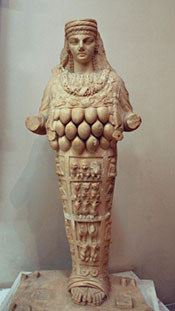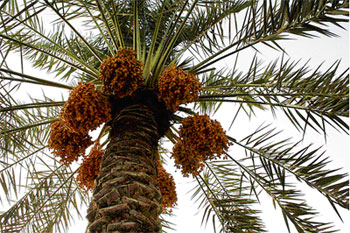The Palm Tree Goddess is a name I have given to what is known from antiquities as the Ephesian Artemis. Copies of this image show a standing goddess, well-dressed and adorned, with the peculiar characteristic of what is called multiple breasts: i.e., a quantity of oval objects hanging around the upper part of her body, as if she has not two but many breasts. The fact that each of these objects do not look particularly like a breast, and having no nipples, did not disturb the initiator of this appellation.
Other scholars must have noticed this discrepancy and decided to call these objects not breasts but bull’s “eggs”, i.e., testicles. They also were not disturbed by the ridiculous idea of hanging a male’s paraphernalia on a female’s neck.

Both, in my opinion, are wrong. Since the first time I saw the statue of this goddess at the Vatican museum in Rome, I knew these hanging objects were neither breasts nor testicles but dates. Not only do they have the shape of dates, as I eat them every day of my life and as I saw them hanging from the upper part of the trunk of a date palm every day of my childhood and youth, but also they identify this particular goddess as one to whom the date palm was sacred.
The World Mythology (s. ref), p. 155, says: “Tradition relates that the amazons built a temple at Ephesus to house a primitive image of a goddess (later identified with Artemis), probably made of a palm trunk.” Modern scholars have denied the statue is that of Artemis, claiming that the Greeks tended to haphazardly identify foreign deities with their own. My aim in this article is to show this particular identification is completely justified.
The date palm grows naturally and has been widely cultivated since ancient times in my homeland of Israel, which is ancient Canaan. What is typical of a nurturing and protecting mother, is also typical of the date palm. In the Jewish commentary on the Bible, called Talmud, it is said about the date palm, called in the feminine form Tmara, from the Hebrew name of the date – Tamar (which is the name of some very important women in the Old Testament, including the Canaanite ancestress of the royal house of David): “Look at this date palm, there is no waste in it. It has dates for eating, hearts for prayer, fronds for covering the roof, fiber for ropes, scales for sieves, and plenty of beams for the house ceiling.” This is how the date palm is like a mother, both for nourishment and for protection.

It is no wonder, then, that “in the oases of the Arabian dessert it (the date palm) was their Mother Goddess.” Mother goddesses were usually concerned with all aspects of life and death, and particularly with fertility.
Wikipedia describes the geographical spread of the palm tree in its site by the name of Phoenix (plant): “Phoenix is a genus of 13 species of palms, native from the Canary Islands east across northern and central Africa, the extreme southeast of Europe (Crete), and southern Asia from Turkey east to southern China and Malaysia. The diverse habitats they occupy include swamps, deserts, and mangrove sea coasts. Most Phoenix species originate in semiarid regions but usually occur near high groundwater levels, rivers or springs. The genus is unique among members of the subfamily Coryphoideae, being the only one with pinnate, rather than palmate leaves.[2] The name derives from a New Latin form of φοῖνιξ, the Greek word for ‘date palm’, probably referring to the Phoenicians who brought the palm with them in their travels or maybe from φοινός, ‘red-colored’, referring to the color of their dates.”
It may be noted that the list sites Turkey, where Ephesus was situated, but not Greece, where the goddess Artemis was worshipped. These facts are going to be explained below.


The two pictures I can see in this article have been loaded perfectly as I opened my e-mail, so I can’t say much about the problem of this reader.